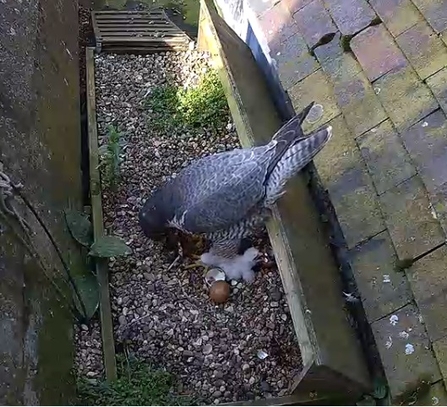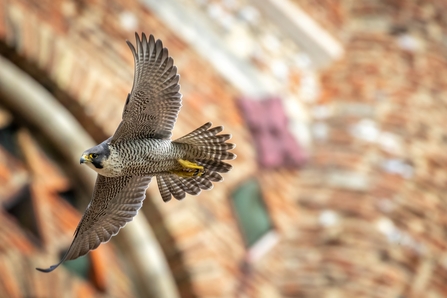The pair of Peregrine Falcons at St Albans Cathedral have captured the public’s interest since they first produced a chick in 2022 and this is the third successive year that their chicks have hatched. In 2022, two eggs were laid but only one female chick hatched. In 2023, the pair, with more experience, produced three male chicks. This year three eggs were laid but so far only two of those have hatched and whilst there is still a chance of the third egg hatching, sometimes one does not hatch as it could be infertile. The sexes of the chicks is usually determined when the birds are ringed at three-weeks’ old.
Two Peregrine Falcon Chicks Hatch on St Albans Cathedral
UPDATE 9/5/24: The third egg has now hatched successfully.

The webcam was installed at St Albans Cathedral in 2023 to provide the public with a birds-eye view of the iconic species. This has proved to be extremely popular and last year it attracted 378k views of the live feed. Everyone can now view the parents and their new chicks via the Cathedral’s website.
Heidi Mansell, Engagement Manager at Herts and Middlesex Trust said:
“We are delighted that two eggs have successfully hatched. This is such exciting news for the natural world and for our community, who really have taken these birds to their hearts.
“The webcam gives us a great window to watch the Peregrines’ behaviour - it‘s such a privilege to have this insight to their antics. I, for one, will be glued to my screen over the next few weeks, watching the parents deliver food to the chicks and hopefully see them develop through to fledging.
“There will be times when the parents will be out of sight but I’d urge people not to worry about this, as they will be close by to protect the chicks. Likewise, as the chicks begin to move around more, they may disappear from the view of the webcam from time-to-time but in all probability, they are just exploring the rest of the nest tray!
“When you see these birds, it really resonates that the latest State of Nature report told us that 43% of birds in Great Britain are at risk of being lost. The Peregrines symbolise how vital it is that humans forge a connection with wildlife so that we can come together to reverse these damning statistics.”

The nesting tray was purposely installed high up on the Cathedral in March 2022, to an area the birds were known to be favouring. The box construction contains shingle to replicate the Peregrine Falcons’ natural cliff-top nesting.
A powerful bird of prey with blue/grey plumage, a white face and a contrasting black moustache, the Peregrine Falcon is extremely quick and agile. It holds the record for being not only the fastest bird in the world, but also the fastest member of the animal kingdom with a diving speed in excess of 200 miles per hour.
The number of breeding pairs of Peregrine Falcons in Southern England are gradually increasing and are mainly using high buildings such as cathedrals, churches and office blocks in our cities, towns and some villages, along with some more natural sites such as quarries. Along with the St Albans pair, there are thought to be four other pairs breeding in Hertfordshire, in Watford, Hemel Hempstead, Welwyn Garden City and Wymondley.
Barry Trevis has been studying breeding Peregrine Falcons across Hertfordshire to help ensure the species’ safety. Barry said:
“Numbers of Peregrine Falcons fell through the first-half of the twentieth century to critical levels in the 1960’s but today they are protected by law as a Schedule 1 listed species of The Wildlife and Countryside Act. It is now an offence to disturb the birds in any way, and this protection has had a positive effect on their numbers, which have slowly increased to a point where the national breeding population is now considered to be in excess of 1,700 pairs.
“The webcam is an excellent tool in helping us to monitor the breeding success of these birds at St Albans Cathedral. We will look to ring the chicks which can help provide information on the birds, giving us valuable insights to their survival rates and movements.”
Canon Will Gibbs commented: “This is wonderful news and yet another expression of our core commitment to the environment and all creation and to the Cathedral and its grounds being a place of welcome for humans and animals alike.”
You can watch the chicks’ progress on the Cathedral’s live feed by visiting https://www.stalbanscathedral.org/peregrine-live-cam Additionally, Herts and Middlesex Wildlife Trust and the St Albans Local RSPB Group are organising Peregrine Watch within the grounds of the Cathedral over weekends throughout spring and summer, starting on 11 May. These events will enable the community to find out more about these magnificent birds of prey from the volunteers on hand and to get a close up view of the Peregrines through telescopes and binoculars, which will be provided. More details of these events can be found at https://www.hertswildlifetrust.org.uk/events
